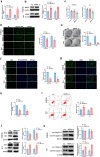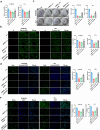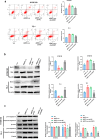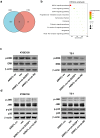Arntl-induced upregulation of DUSP1 inhibits tumor progression in esophageal squamous cell carcinoma by inactivating ERK signaling
- PMID: 39341782
- PMCID: PMC11445925
- DOI: 10.1080/15384047.2024.2408042
Arntl-induced upregulation of DUSP1 inhibits tumor progression in esophageal squamous cell carcinoma by inactivating ERK signaling
Abstract
Background: Esophageal squamous cell carcinoma (ESCC) is a primary histological type of esophageal carcinoma with high morbidity. Aryl hydrocarbon receptor nuclear translocator-like (ARNTL) is a circadian clock gene associated with the progression of multiple tumors. However, its roles and mechanisms in ESCC remain unknown.
Methods: ARNTL expression was analyzed using TCGA database and detected using qRT-PCR, and ARNTL-related pathways were analyzed through GSEA. Cell functional behaviors were assessed in vitro by measuring cell viability, proliferation, and apoptosis. Cell growth in the murine model was investigated through xenograft model and immunofluorescence assays of PCNA and Ki67. The downstream targets of ARNTL were analyzed through sequencing and identified via luciferase report, ChIP, and RNA pull-down analyses. Dual-specificity protein phosphatase-1 (DUSP1) expression was analyzed using GEO datasets and measured using qRT-PCR and western blotting. Protein expression was examined via western blotting.
Results: ARNTL expression was decreased in esophageal carcinoma and associated with histological types, and elevated expression of ARNTL repressed ESCC cell viability and proliferation and facilitated cell apoptosis. ARNTL upregulation reduced tumor cell growth in murine models and decreased PCNA and Ki67 levels. Furthermore, DUSP1 was downregulated upon ARNTL silencing in ESCC. ARNTL could bind and positively regulate DUSP1 transcription. Additionally, DUSP1 silencing reversed the influences of ARNTL upregulation on cell viability, proliferation, and apoptosis in ESCC cells. ARNTL attenuated the activation of the ERK signaling by decreasing ERK phosphorylation through upregulation of DUSP1.
Conclusion: ARNTL hinders cell growth and contributes to cell apoptosis by inactivating ERK signaling through transcriptional upregulation of DUSP1 in ESCC.
Keywords: ARNTL; DUSP1; ERK; Esophageal squamous cell carcinoma; apoptosis.
Plain language summary
• ARNTL is differentially expressed in ESCC and associated with cell apoptosis.• ARNTL augments cell apoptosis.• ARNTL increases DUSP1 transcription.• ARNTL inhibits activation of the ERK signaling by upregulating DUSP1.• DUSP1 silencing reverses the effects of ARNTL in esophageal squamous cell carcinoma.
Conflict of interest statement
No potential conflict of interest was reported by the author(s).
Figures








Similar articles
-
Circular RNA circNTRK2 facilitates the progression of esophageal squamous cell carcinoma through up-regulating NRIP1 expression via miR-140-3p.J Exp Clin Cancer Res. 2020 Jul 11;39(1):133. doi: 10.1186/s13046-020-01640-9. J Exp Clin Cancer Res. 2020. PMID: 32653032 Free PMC article.
-
SUMO modified ETV1 promotes M2-polarized tumor-associated macrophage infiltration and cancer progression by facilitating CCL2 transcription in esophageal squamous cell carcinoma cells.Cancer Immunol Immunother. 2025 Feb 1;74(3):87. doi: 10.1007/s00262-024-03914-z. Cancer Immunol Immunother. 2025. PMID: 39891717 Free PMC article.
-
MTA1 promotes tumorigenesis and development of esophageal squamous cell carcinoma via activating the MEK/ERK/p90RSK signaling pathway.Carcinogenesis. 2020 Sep 24;41(9):1263-1272. doi: 10.1093/carcin/bgz200. Carcinogenesis. 2020. PMID: 31783401
-
Long non-coding RNA LINC00337 induces autophagy and chemoresistance to cisplatin in esophageal squamous cell carcinoma cells via upregulation of TPX2 by recruiting E2F4.FASEB J. 2020 May;34(5):6055-6069. doi: 10.1096/fj.201900731RR. Epub 2020 Apr 2. FASEB J. 2020. PMID: 32239565
-
Long non-coding RNA XIST promotes the progression of esophageal squamous cell carcinoma through sponging miR-129-5p and upregulating CCND1 expression.Cell Cycle. 2021 Jan;20(1):39-53. doi: 10.1080/15384101.2020.1856497. Epub 2020 Dec 19. Cell Cycle. 2021. PMID: 33345719 Free PMC article.
Cited by
-
The circDUSP1/miR-429/DLC1 regulatory network affects proliferation, migration, and invasion of triple-negative breast cancer cells.Sci Rep. 2025 Jul 20;15(1):26300. doi: 10.1038/s41598-025-11621-7. Sci Rep. 2025. PMID: 40683918 Free PMC article.
References
MeSH terms
Substances
LinkOut - more resources
Full Text Sources
Medical
Miscellaneous
